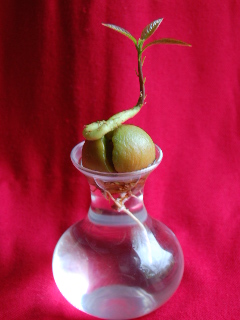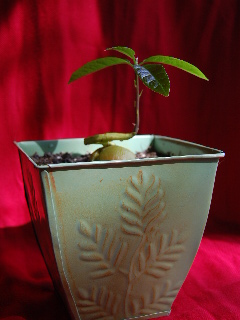
Growing an avocado tree from a seed is a fun family project that produces a beautiful houseplant. This horticultural experiment can also become an unusual entry into the science fair.
The project starts the moment you cut open the avocado fruit. Remove the seed and wash it lightly under cold running water. The seed bears a similar appearance to dormant bulbs such as daffodils or tulips. Determine the top, or growing end, of the seed and the bottom end from which the roots will emerge. Sometimes, the seed will have already started to split open when you open the fruit, making it easy for you to determine the proper orientation. The bottom of the seed is a bit more broad and flat, while the top is more rounded or pointed.
You’ll need a small, transparent, glass jar or bud vase filled almost to the top with water. Set the seed on top of the bud vase so the bottom end extends well down into the water, or if you’re using a jar with a larger opening, suspend the seed into the water by poking 3 or 4 toothpicks into the circumference of the avocado seed and letting the toothpicks rest on the top edge of the glass.
Place the seed container in a warm location, where you can observe it everyday. Keep a close eye on the water level and be sure the bottom of the seed always stays wet. Because of evaporation and water uptake, you’ll need to add just a small amount of water fairly frequently. A windowsill in the kitchen or bathroom is a good place to keep your project. Roots may begin to sprout from the bottom of the seed in just a few days, or it could take several weeks for this to happen. Once the roots start, they will thicken pretty quickly as the top stem also grows and puts out leaves.

When the top growth has reached 5 or 6 inches in height and the roots are thick, the avocado plant can be set into a small container of rich potting soil. The top half of the seed should be above the level of the soil. The soil of the potted houseplant should be kept lightly moist but not saturated.
The plant should be in a location that receives plenty of sunlight as it continues to grow and produce more leaves. As the plant reaches up to a height of 10 or 12 inches, it can start to become slender and leggy. This is a good time to cut it back a few inches in order to encourage the growth of lateral shoots and give the plant a fuller form. At this point, the avocado plant should be treated like other houseplants, giving it periodic waterings, light plantfood feedings, and transplantings into larger pots as it grows larger and the roots and top continue to spread.
On warm sunny days, the potted plant can be set outdoors onto the deck or porch. Although the avocado tree will grow larger and makes a nice container plant for the patio, it probably will not bear any fruit as this usually requires grafting. Take care of your plant, and you should be able to enjoy it for many years.
Avocados contain lutein, which is a natural antioxidant that may help maintain eye health as we grow older. They also contain beta-sitosterol, a natural plant sterol which may help maintain healthy cholesterol levels. Avocados contain nearly 20 vitamins and minerals that can contribute to a healthy diet. One of the amazing things about the nutritional value of the avocado is that it is virtually the only fruit that has monounsaturated fat. These and other interesting facts and nutritional information concerning the avocado can be found at the website of the California Avocado Commission.
 Growing an avocado tree from a seed is a fun family project that produces a beautiful houseplant. This horticultural experiment can also become an unusual entry into the science fair.
Growing an avocado tree from a seed is a fun family project that produces a beautiful houseplant. This horticultural experiment can also become an unusual entry into the science fair.
 When the top growth has reached 5 or 6 inches in height and the roots are thick, the avocado plant can be set into a small container of rich potting soil. The top half of the seed should be above the level of the soil. The soil of the potted houseplant should be kept lightly moist but not saturated.
When the top growth has reached 5 or 6 inches in height and the roots are thick, the avocado plant can be set into a small container of rich potting soil. The top half of the seed should be above the level of the soil. The soil of the potted houseplant should be kept lightly moist but not saturated.